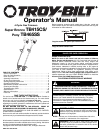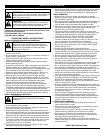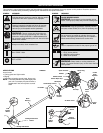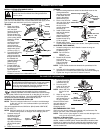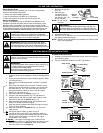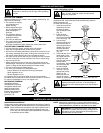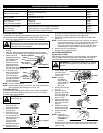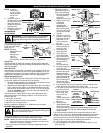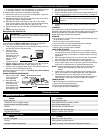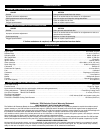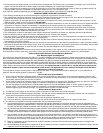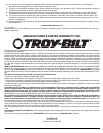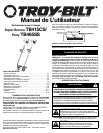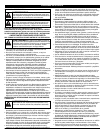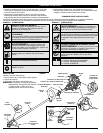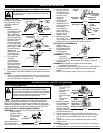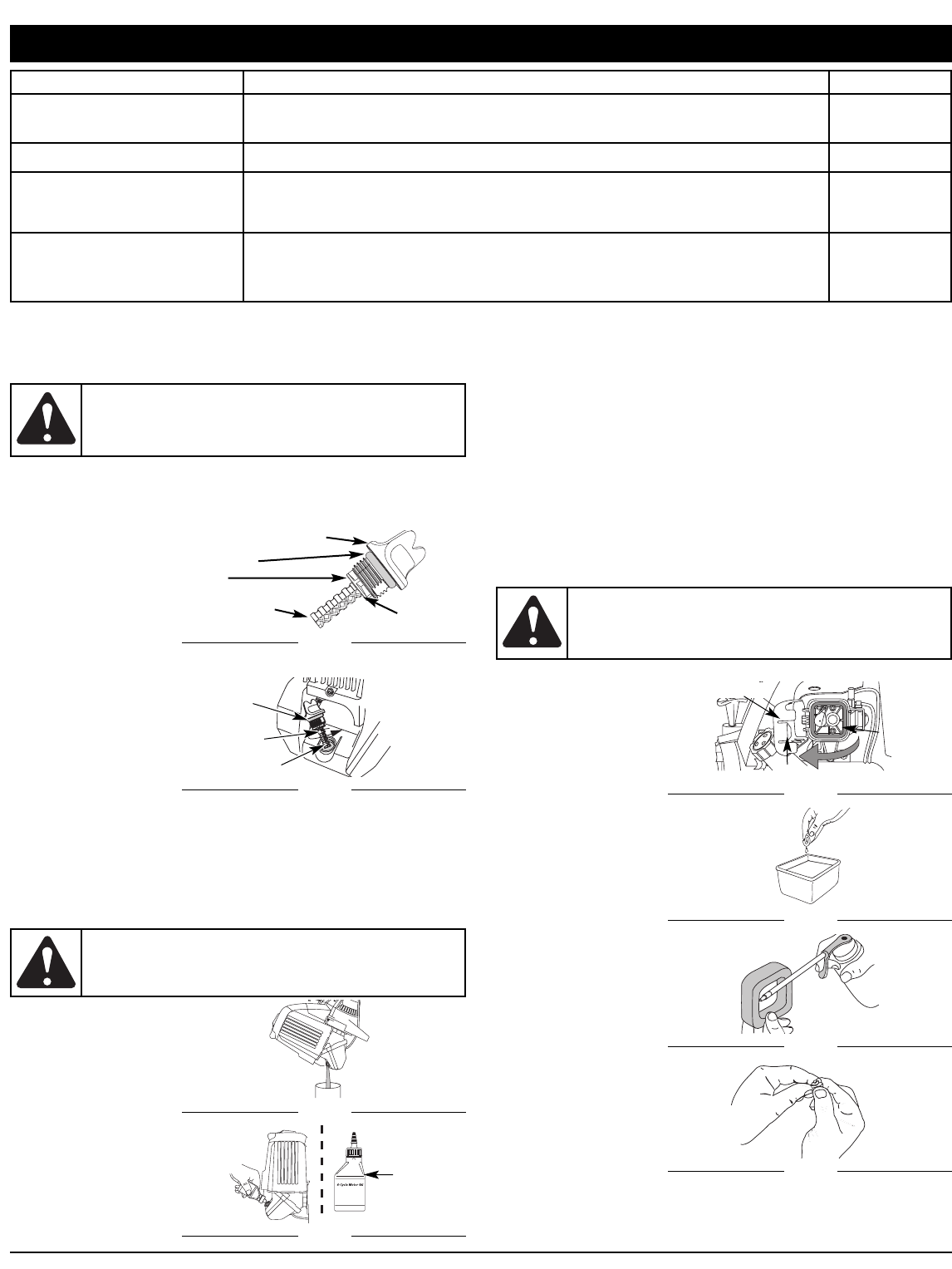
7
MAINTENANCE AND REPAIR INSTRUCTIONS
FREQUENCY MAINTENANCE REQUIRED SEE
Before starting engine
Fill fuel tank with fresh fuel
Check Oil
Page 4
Page 7
Every 10 hours Clean and re-oil air filter Page 7
First change at 10 hours
Every 25 hours
Every 25 hours thereafter
Change Oil
Change Oil
Clean spark arrestor
Page 7
Page 7
Page 9
10 hours on new engine
Every 25 hours
Every 25 hours
Check rocker arm to valve clearance and adjust
Check rocker arm to valve clearance and adjust
Check spark plug condition and gap
Page 8
Page 8
Page 9
CHECKING THE OIL LEVEL
The importance of checking and maintaining the proper oil level in the
crankcase cannot be overemphasized. Check oil before each use:
1. Stop the engine and allow oil to drain into the crankcase.
2. Place the unit on a flat, level surface to get a proper oil level
reading.
3. Keep dirt, grass clippings and other debris out of the engine.
Clean the area around the oil fill plug/dipstick before removing it.
4. R
emove the oil fill
plug/dipstick and wipe
off oil. Reinsert it all
the way back in.
5. Remove the oil fill
plug/dipstick and
check the oil level.
Oil should be up to
the top of the dipstick (Fig. 21).
6. If the level is low,
add a small amount
of oil to the oil fill
hole and recheck
(Fig. 22). Repeat this
procedure until the
oil level reaches the
top of the dipstick.
NOTE: Do not overfill the unit.
NOTE: Make sure the O-ring is in place on the oil fill plug/dipstick
when checking and changing the oil (Fig. 22).
CHANGING THE OIL
For a new engine, change the oil after the first 10 hours of operation.
Change the oil while the engine is still warm. The oil will flow freely
and carry away more impurities.
1. Unplug spark plug
boot to prevent
accidental starting.
2. Remove the oil fill
plug/dipstick.
3. Pour the oil out of
the oil fill hole and
into a container by
tipping the unit to a
vertical position
(Fig. 23). Allow
ample time for
complete drainage.
4. Wipe up any oil
residue on the unit
Fig. 21
Top of Dipstick
O-Ring
Oil Fill Plug/Dipstick
Full
Add 1.4-1.5 Oz.
(41-44 ml)
CAUTION:
To prevent extensive engine wear and
damage to the unit, always maintain the proper oil level
in the crankcase. Never operate the unit with the oil level
below the bottom of the dipstick.
and clean up any oil that may have spilled. Dispose of the oil
according to Federal, State and local regulations.
5. Refill the crankcase with 3.04 fluid ounce (90 ml) of SAE 30 SF,
SG, SH oil.
NOTE: Use the bottle and spout saved from initial use to measure
the correct amount of oil. The top of the label on the bottle
measures approximately 3.04 ounces (90 ml) (Fig. 24).
Check the level with the dipstick. If the level is low, add a
small amount of oil and recheck. Do not overfill (Fig. 24).
6. Replace the oil fill plug/dipstick.
7. Reconnect the spark plug boot.
AIR FILTER MAINTENANCE
Cleaning the Air Filter
Clean and re-oil the air filter every 10 hours of operation. It is an important
item to maintain. Failure to maintain your air filter properly can result in
poor performance or can cause permanent damage to your engine.
1. Open the air filter cover. Push the tab on the right side of the
cover inward. Then
pull the air filter
cover out and to the
left (Fig. 25).
NOTE:
It may be
necessary to
remove the fuel
cap to completely
remove the air
filter cover.
2. Remove the air filter
(Fig. 25).
3. Wash the filter in
detergent and water
(Fig. 26). Rinse the
filter thoroughly and
allow it to dry.
4. Apply enough clean
SAE 30 motor oil to
lightly coat the filter
(Fig. 27).
5. Squeeze the filter to
spread and remove
excess oil (Fig. 28).
6. Replace the filter
(Fig. 29).
NOTE: If the unit is
operated without
the air filter, you
will VOID the
warranty.
7. Reinstall the air filter cover. Position the hooks on the left side
of the air filter cover into the slots at the left side of the back
plate (Fig. 30).
Fig. 22
Oil Fill
Plug/Dipstick
O-Ring
Oil Fill Hole
CAUTION:
Wear gloves to prevent injury when
handling the unit.
Fig. 23
Fig. 24
Fill Level
Fig. 25
Air Filter
Tab
Air Filter Cover
WARNING:
To avoid serious personal injury, always
turn the unit off and allow it to cool before you clean or
service it.
Fig. 26
Fig. 27
Fig. 28



